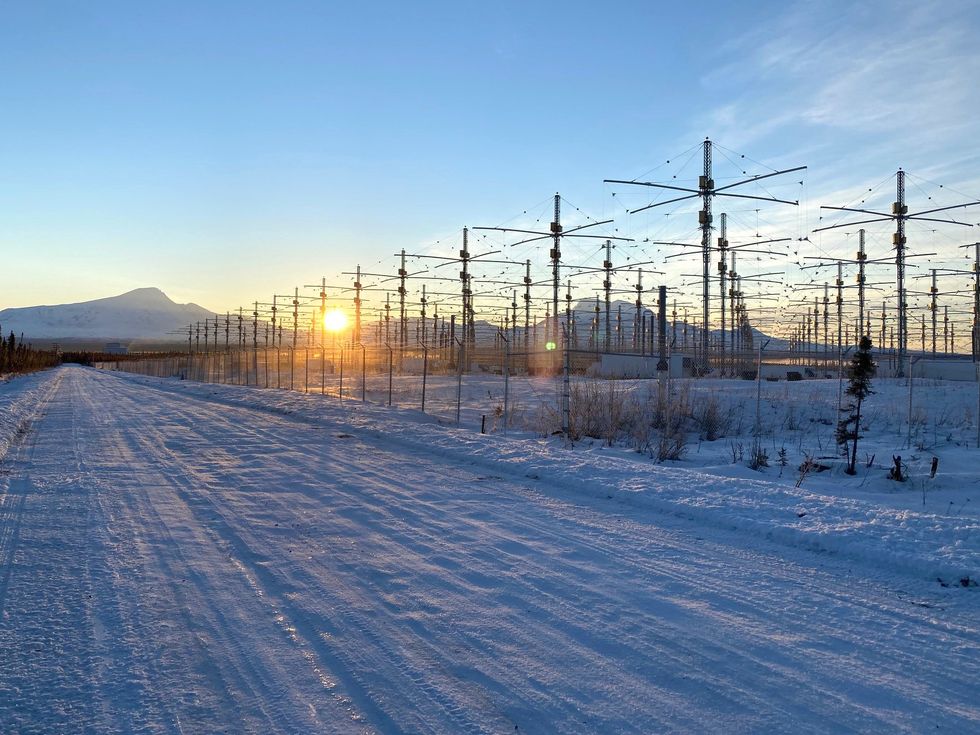This Weekend, the Ionosphere Becomes a Canvas

High above our heads, the ionosphere haloes the world with a haze of charged particles. The ionosphere was once critical to global telecommunications, because shortwave radio signals reflect off it, and so they can bounce all around the planet. Fiber-optic and satellite communications have largely displaced shortwave radio. But the ionosphere still offers unique opportunities, such as the ability to create truly global pieces of art. That's what broadcast artist Amanda Dawn Christie is doing this Sunday evening/Monday morning. She's using an enormous array of radio antennas-and you could be an essential part of her artwork.
Christie is one of a small cadre of transmission artists. These artists don't just use radio waves as convenient carriers for things like music. They are interested in the waves themselves. I'm working with energy as a material for artistic creation," explains Christie, based in Lutes Mountain, New Brunswick, Canada, is one of a small cadre of transmission artists. IEEE Spectrum previously covered some of Christie's earlier work, which was inspired by the fading away of old shortwave radio stations. Her latest work uses the advanced technology of the High-frequency Active Auroral Research Program (HAARP) in Gakona, Alaska.
What is HAARP? And how does it work?HAARP was originally established as a research facility by the U.S. Air Force and U.S. Navy in the early 1990s, but in 2015 the facility was turned over to the University of Alaska, Fairbanks, and its Geophysical Institute. HAARP's most visible feature is the Ionospheric Research Instrument (IRI), an array of antennas spread out over 13 hectares that can transmit signals between 2.7 and 10 megahertz. Normally, scientists use this array, along with ancillary instruments, to probe the ionosphere and phenomena within it, such as the spectacular aurora visible when the solar wind is funneled by magnetic lines of force into Earth's upper atmosphere.
Christie's piece-entitled Composition No. 3-has been created specifically to engage with some of HAARP's capabilities," says the artist. Because it's a phased array with 180 antennas, you can do quite a lot with it. Counterrotating beams, directing it at different places....I'm most interested in Luxembourg' experiments, in which you send up two frequencies 500 kilohertz apart, and they mix in the ionosphere and come down together. It's like using the ionosphere as a giant mixing board."
The artwork is not complete until it interacts with the atmosphere....I'm collaborating with both the atmosphere and with the listeners."
-Amanda Dawn Christie
Composition No. 3 is, as the name suggests, Christie's third piece for the HAARP array. She previously visited the array in 2019 and 2022. Her first visit was intended to be just a technical test to explore the facility's capabilities. However, questions about funding meant there was suddenly no guarantee of a later visit, so Christie quickly put together an artistic program incorporating slow-scan television (SSTV) images and audio messages. Her second visit was more ambitious: Among other things, she used the HAARP array to create an air glow in the ionosphere, essentially an artificial aurora. Christie says her latest work, which will be broadcast only once and will be her final transmission from HAARP, will incorporate what worked best from her earlier compositions and include new elements. These include transmitting images that can be seen only by looking at a digital waterfall display of the received signal. Composition No. 3 has 10 distinct movements, some contributed by other artists, so listeners without access to digital equipment will still be able to listen to items like radio-related poetry in other movements.
Christie would like anyone who picks up her transmissions to log a report through a form on her website and share any recordings or screenshots they make. These reports will then go into a concluding art piece. For anyone interested in becoming part of Composition No. 3, even as just a listener, Christie's broadcast will begin at 03:30 UTC on Sunday and last for an hour. The exact frequencies will be posted before the transmission, but they are expected to be close to 9 MHz, a little below the 31-meter band used by many shortwave broadcast stations. SSTV images will be sent using the audible Scottie S1 protocol, which can be decoded using a smartphone app held up to a radio's speaker, if you don't have anything more elaborate. Christie promises that anyone who does submit a report will receive an artifact originating in the glory days of broadcast radio: a physical QSL card sent through the mail.
Reception is as important to the work as its transmission, says Christie. For those without access to their own shortwave radio, and ideally a software defined radio, Composition No. 3 will be simulcast online. But I feel like the artwork is not complete until it interacts with the atmosphere and is [received]," she says. I feel like I'm collaborating with both the atmosphere and with the listeners, because there is also an element introduced by people. For instance, as they are decoding SSTV, how they've got their phase and skew settings set. What they receive depends on their equipment and how they are set up, so I feel like it's a joint work."